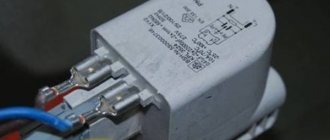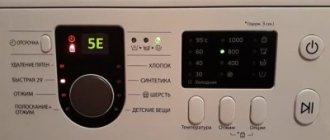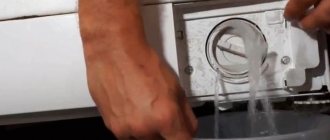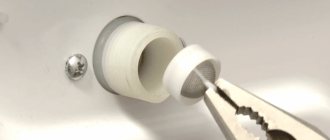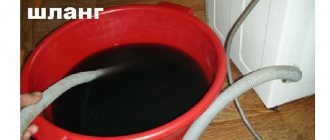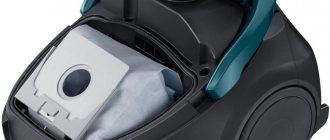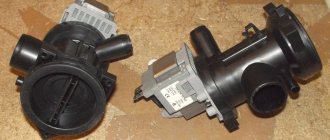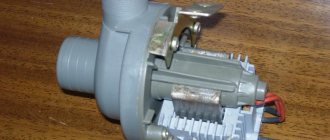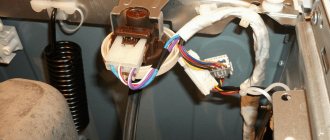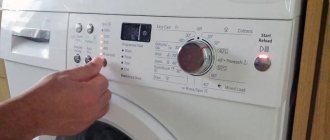Washing machine manufacturers produce sophisticated electronic devices with many functions that make life much easier for their owners. They can do everything - perform high-quality washing, steam and dry clothes. However, “smart” units remain defenseless against hard and rusty pipeline water.
How to prevent damage to your home assistant? This question is asked by many owners and potential buyers of washing machines. One of the effective methods is to install a filter for the washing machine, which protects the working units of the equipment from premature damage.
Let's figure out what types of filter elements exist, what are the features of their selection, installation, application and maintenance. The information presented will help organize comprehensive protection for the washing machine and extend the life of expensive equipment.
The effect of untreated water on washing machine parts
Rumor has it that the washing machine can function smoothly without any filters for many years. However, in modern realities this is far from the case. The reason for this is various impurities that pollute the water. What could they be?
Mechanical impurities (dirt, sand, small debris), if not removed, can over time significantly clog the internal cleaner. The pressure required to start water will gradually drop, which may cause the pump to break down and the device will stop drawing water.
Rust has a detrimental effect on the result of washing, because things fade, acquire new stains or are not washed at all.
If you do not promptly clean the water filter in your washing machine, the purifier will become clogged. And this may lead to machine breakdown
Hard water is no less dangerous. When heated, mineral deposits from the water settle on the heating element and the walls of the apparatus in the form of impenetrable scale. And this can provoke an increase in energy consumption to heat the water to the required temperature.
It is necessary to remove scale in a timely manner, otherwise a more serious breakdown may occur, requiring expensive repairs. To maintain the washing machine, you must periodically use an anti-scale agent.
In addition, hard water provokes corrosion - it is the key reason for the rapid wear of important parts and a decrease in the service life of the machine.
Also, untreated water often becomes a decisive factor in machine depressurization due to a decrease in the elasticity of rubber seals.
Situations indicating that it is necessary to clean a clogged filter:
- after washing or rinsing, the process of draining the water is incredibly slow;
- the machine completes the washing cycle and does not continue it even after rebooting the processor;
- a fault code flashes on the monitor, the direct cause of which may be untreated water;
- The spin or rinse modes do not start.
If such failures in the operation of the washing machine occur frequently, then it is worth thinking about the quality of water filtration.
How to clean the drain and fill filter
Initially, in all washing machines, for their productive and safe operation, the manufacturer already provides two factory filters:
- filler (or inlet) - installed immediately after the inlet pipe;
- drain (or outlet), which removes water after washing/rinsing.
Let's look at the design and maintenance features of each filter.
Overview of the inlet cleaner and its service
The inlet filter is mounted at the junction of the inlet hose with the machine. And at the very bottom of the device there is a drain filter; in various models it is located either on the left or on the right and is covered with a special rectangular cover.
Its main function is to retain large and medium-sized debris, which can cause malfunction or breakdown of the machine.
The instructions for the washing machine say that you need to call a specialist to clean the filters. But if the user is familiar with the tools, he will be able to perform these simple steps independently.
The inlet filter is cleaned in all brands and models according to the same principle - you need to carefully remove the thimble-like device using pliers
First, you need to disconnect the device from the network, turn off the water and free access to the back of the device. Be sure to place a piece of thick rag under the bottom of the washer to prevent water from flowing in there, and carefully unscrew the water-filling hose.
Then carefully remove the cleaner (it looks like a thimble) using tweezers or pliers. It is necessary to rinse the metal filter mesh under running warm water, using a toothbrush to remove dirt.
Then wipe with a rag (do not use a cloth with very long pile). After this, install the part in place and screw the hose.
The procedure for cleaning the drain type of filter
Different brands of laundry appliances differ slightly in design, and drain cleaners also differ.
Indesit washing machines , for example, the drain filter is cleaned in this way:
- You should carefully open the panel located on the left or right bottom of the device;
- remove the inner part by unscrewing the plug counterclockwise;
- After removing dirt and debris, you need to screw the element tightly in a clockwise direction until it stops.
When cleaning the filter of a Samsung , be sure to pay attention to the location of the screw handle.
In some models, for a tight seal, it must be locked in the correct position. If this is not done, water will flow out of the drain cleaner during the wash set.
The inlet mesh filter for purifying water in a washing machine is a small part that, if washed frequently, must be cleaned at least once every 3 months.
You can avoid contamination of the drain filter if you follow simple rules for its operation. It is necessary to wash the part regularly to prevent dirt from accumulating.
If you wash it a couple of times a day or once every 2 days, then it is enough to do only 1 cleaning every 3 months. In addition, you should carefully check pockets and other recesses in dirty laundry to prevent dirt, hair, and small parts from getting into the drum.
Try to use only proven detergents. It is better to test new ones by hand washing, since large particles of powder can only partially dissolve in water and clog the cleaner, especially if the program involves the use of cold water.
How does a polyphosphate filter work?
- There are two options for constructing salt filters based on the type of polyphosphate arrangement:
- in the first case, the substance is poured directly into the flask,
- and in the second it is placed in a special container, which is inserted into the flask like a cartridge.
- Also, similar filters are divided into types according to the method of water distribution:
- direct-flow filters drive the entire water flow through the salt substance;
- filters with dispensers distribute the water flow into two parts, one part is purified with polyphosphate and returned to the general flow.
Thus, the water is softened to the desired hardness. Devices with dispensers can have the function of changing the level of water softening, and single-jet filters bring the liquid to a certain, non-adjustable parameter.
Installation
The installation process is simple and does not take much time and effort. To install, you need to unscrew the inlet hose of your equipment, attach the polyphosphate filter to the hose or water supply tap using the threaded hole in the filter cover and attach the inlet hose to the second threaded hole in the cover or filter housing. During the first test run, you must ensure that there are no leaks through the connected elements.
Service
Let's try to calculate the approximate average cost of purchasing and servicing a polyphosphate filter using the example of a washing machine. The average cost of purchasing a polyphosphate filter for a washing machine is 350 rubles. The filter already contains a backfill, which, according to the manufacturer, is enough for 300 washes with low water hardness.
Taking into account that the average family with children washes once every 2-3 days, this backfill should be enough for 150 days, i.e. a little less than six months of use. Next, you need to purchase backfill, the average cost of which is 200 rubles. to the filter capacity. In total, you will spend no more than 550 rubles per year.
Polyphosphate salt for filter
During operation, water gradually dissolves sodium polyphosphate crystals, so the filter must be periodically filled with this filter substance. Typically, sodium polyphosphate is replaced every 3-6 months, depending on the source water.
For polyphosphate filters, technical sodium polyphosphate is used as backfill for water softening. Among all other polyphosphates, it is the most active water softener with high chelating ability.
Sodium polyphosphate forms stable complexes in a shorter time and at lower temperatures (20-40 ° C) than sodium tripolyphosphate and other phosphates. Its advantages also include low caking during storage and anti-corrosion properties.
How to find out when you need to change the filter media
Over time, polyphosphates are completely consumed by binding calcium and magnesium ions and then the filter stops working. At this moment it is necessary to change the backfill. It is visually quite difficult to understand exactly when this process begins, since the backfill does not always dissolve completely, and the binding of calcium and magnesium ions may no longer occur. The exact timing of replacing the polyphosphate backfill can only be determined by water analysis. However, in domestic conditions no one will do regular water analysis. Therefore, the backfill is changed at the intervals specified in the instructions.
The solubility of the backfill depends on the fraction. If the fraction is large, it dissolves, but not so quickly. However, over time, a film forms on the surface of the crystals, which looks like rust and begins to prevent dissolution. That’s why the instructions say that it is recommended to change the load once every six months.
The resource of a polyphosphate filter cartridge depends on its volume and the degree of water hardness. The approximate timing for replacing the backfill should be indicated in the technical data sheet for the product. The average replacement of backfill is six months. With high water hardness, the backfill can completely dissolve in 2-3 months. With softer water, the cartridge can last for a year.
Types of cleaning devices
To protect the parts of the electrical device from mechanical particles and chemical contaminants, users install special water purifiers for the washing machine.
Main filters . Such devices are installed on a common water supply pipe. The functionality of the main device is similar to a filler cleaner.
It is mounted on the inlet pipe to purify the incoming water from rust, sand and large particles. Please note that this type of filter does not affect the chemical and biological composition of water.
To install the main filter, it is necessary to make a separate insert in the pipe. The general cleaner is installed immediately after the meter and in front of the inlet hose.
The main filter is necessary for deep purification of water from mechanical impurities (dirt, debris, sand); it looks like a flask with an active filler inside
The coarse filter performs functions similar to the main filter, and at the same time it must be installed in front of the washing machine.
Please note that filters become clogged quite quickly. Therefore, it is necessary to regularly clean them and change replacement cartridges so that the washing machine lasts as long as possible.
Replacing the main cleaner cartridge is very simple - just turn off the water, carefully unscrew the flask and replace the old one with a new cartridge
The user can install a coarse filter for the machine without the help of specialists. You don't need to use any complicated tools to do this. Just take a wrench and screw the filter to the machine. The flask is mounted in front of the inlet hose.
To install, do the following:
- Turn off the water.
- Unscrew the inlet hose from the pipe to which it is attached.
- Install a water filter-purifier in its place.
- Then screw on the hose itself.
The cleaner uses standard threads that fit three-quarter inch pipes. The washing machine hose has exactly the same thread.
The quality of water purification will directly depend on the type of filter and how contaminated the tap water flowing through the pipes is.
To purify water at the biological level, softener filters are used:
- polyphosphate;
- magnetic.
Devices of this kind remove the notorious hardness from water, especially calcium carbonate salts. Their action is based on chemical or magnetic cleaning methods. Please note that after such filtering, process water will flow through the pipes and cannot be used for drinking.
Why do you need a filter?
Filtering devices for automatic machines are used in two cases:
- with increased water hardness;
- if there are a large number of small particles of dirt, rust, sand in it.
When they talk about excessive hardness of water, they mean an increased level of calcium and magnesium bicarbonates in it, with which it is “saturated” when passing through underground sources (boreholes, wells). When heated, the salts crystallize, forming a limescale crust (scale) on the SMA elements. The consequences of such formations are obvious - premature wear of important mechanisms (heating element, solenoid valve).
Mechanical impurities also negatively affect the operation of the automatic machine. They clog its internal parts and also significantly reduce the quality of the wash itself.
Therefore, softening and purification of incoming water flows is the main procedure in the comprehensive care of equipment, which household filtering devices do an excellent job of.
Features of additional filters
We will outline the features of various devices for water purification, describe their operating principles, installation specifics, and also find out the effectiveness of their use.
#1 - polyphosphate cleaning tool
A polyphosphate filter is a flask with large transparent grains similar to salt. It directly affects the biochemical composition of water. After purification with this filter, water becomes technical.
The principle of operation is based on the slow passage of liquid through sodium polyphosphate. When its active element reacts with water, it binds carbonates (a base of hardness salts) and blocks their path to the heating element and other parts of the washing machine.
Such filters are connected to a pipe with cold water, since at temperatures above +50 ° C the salt itself begins to break down, and in this case there will be no effect from this filter.
From time to time you will need to add polyphosphate to the filter flask, as its components dissolve.
Manufacturers recommend changing the filter filler if the contents of the flask have decreased by 50% or the contents of the container have not changed for a long time. As practice shows, crystals retain their cleansing functions for six months.
The polyphosphate filter protects the heating element of the washing machine from scale. Remember that after such cleaning, water can only be used for technical needs
The polyphosphate filler itself can be produced in different forms. Most often it can be seen in the form of translucent granules. Less popular is the powder version, which is produced in the form of pressed white tablets.
Experts recommend using the first option for washing machines, as it dissolves more efficiently and quickly, covering a larger area. Sometimes sodium polyphosphate is hidden under the name "Graham's salts."
Subtleties of installing a filter flask
A polyphosphate cleaner is installed in the same way as a deep cleaning filter. It should be mounted in front of the machine. Installation and replacement of the active filter substance can be handled without the help of a specialist.
#2 - filter for water deferrization
The presence of iron does not affect the operation of the washing machine in any way, since the process of deferrization of water occurs at the city’s water pumping stations. But what if you live outside the city or in the country?
First, conduct an experiment. Fill a glass jar with clean water. Place in a bright place for about 3 days. If, after this period, the walls are covered with a yellow coating (like rust) and the water has acquired a shade of the same color, then iron removal should be carried out.
There is no point in installing such a device for deferrization of water at the dacha, but residents of country houses need it
In this situation, a special filter is needed - a rather bulky device filled with “green sand”. In simple words, the principle of its action is the “transition” of divalent iron into trivalent iron.
Purifier installation specifics
Installation of the deferrization filter should only be carried out by specialists. Before installation, a water analysis is required. To install this device, you need to allocate a special place.
#3 - magnetic type of cleaner
The operating principle of a magnetic filter is based on the influence of a magnetic field on the structure of water in the pipe through which it flows.
In simple terms, the cleaner dissolves the calcite. It is this that makes the water harder and, accordingly, provokes the formation of scale when the heating element is heated.
The magnetic cleaner is attached directly to the water supply pipe to the machine; it does not require cartridge replacement
Calcite particles in their natural state stick to each other, thereby creating chains, so a deposit of the substance is formed on the machine part.
The magnetic field breaks these bonds and therefore the water purified by such a filter is actually softer. And the scale, which has already stuck to the walls of the machine, disintegrates and its particles, falling into the water, lose the ability to re-deposit on the surface.
That is why treated water tends to free the walls of the washing machine from other various sediments. Washing in such water requires less detergent, and the filter itself does not need to be cleaned.
Nuances of installing magnetic filters
Some models of magnetic purifiers consist of 2 elements that are attached directly to the top of the pipe through which water is supplied to the machine. Both parts of the magnetic filter are fastened together using screws.
What to look for when choosing?
If the water in the tap contains visible impurities that precipitate, it is advisable to install a general main purifier.
When this is not possible, the filter should be installed directly in front of the washing machine.
If you are sure of the hardness of your tap water, then it makes sense to install polyphosphate (economical option) or magnetic purifiers (more expensive purchase)
If you doubt whether a water softening filter is needed, order a laboratory test. It will show the chemical composition and level of hardness. Based on this information, decide which cleaner to purchase.
To find out the hardness of water at home, you need to carry out a basic experiment. To do this, soap your hands or a small rag with laundry soap (72%) and rub them.
If fluffy foam forms, then the water is soft and a filter is not needed, otherwise you should think about installing a softener.
How filters work
Depending on the filter model, various membrane gaskets are used that prevent the penetration of certain types of contaminants in the water, such as iron and hardness, as well as scale, into the mechanical parts of the washing machine.
With an additional filter, the service life of the washing machine can be extended several times.
Such devices are installed directly on the source of tap water. Under pressure, the liquid goes through several stages of filtration with sorbents and other granular compounds that retain rust along the way and soften the water. They, like standard filters for drinking water purification, must be changed several times a year.
It is first necessary to determine what type of filtration is needed for tap liquid.
